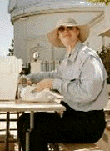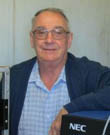|
|
This topic comprises 2 pages: 1 2
|
|
Author
|
Topic: Sound on a hobby implementation...
|
Craig Huegen
Film Handler
Posts: 24
From: Bartelso, IL, US
Registered: May 2013
|
 posted 06-06-2013 06:56 PM
posted 06-06-2013 06:56 PM




Hi all,
Many years ago I used to be the pimply-faced kid projectionist at a local drive-in, first learning carbon-arc and then to a Xenon/platter conversion. At the time, I never learned all the details about the technical stuff behind it, I just ran the show.
Fast forward 20 years, after the (different) local theater's conversion to digital projection, I was given the projection equipment; however, no processors or amps were left after the theater changed hands. It's a Simplex X-L projector with SH-1000 sound head. Exciter bulb's been replaced with a JaxLight, and the preamp is stuffed in the back of the sound head - mono cell only with original slit-lens.
Where I need help? Mono sound. I'm trying to connect that path to a consumer amp that has only unbalanced, line level inputs. I also have a vacuum-tube mic pre-amp to get the signal to a line level.
I have read that a 680-ohm resistor in parallel with the photocell will allow for it to be used without a processor, connected to a mic input / pre-amp.
So, my questions:
* Does the JaxLight change that approach at all?
* Should I still use the JaxLIght "line amp", and if so, where should the resistor go -- still on the photocell input, or the output, or shouldn't need it? Any adjustment to the value of the resistor?
* If the JaxLight line amp is used, which terminals should be used for attaching to an unbalanced amp? E/L+ or L-/L+? Do I need to do impedance matching between cold and shield, or just tie them together?
* How should the whole mess be grounded/shielded?
* Any other tips or tricks?
I briefly tried a 470 ohm resistor on the non-amped photocell and couldn't really hear a thing at full volume, which makes me think I'll need that amp in there.
I know this set of questions is out of the ordinary, but I have the film path working (including the platters), I have a replacement for the 3-phase Christie Xenon supply working reasonably, and now it's just a matter of getting the sound to work.
| IP: Logged
|
|
|
|
Craig Huegen
Film Handler
Posts: 24
From: Bartelso, IL, US
Registered: May 2013
|
 posted 06-08-2013 10:16 PM
posted 06-08-2013 10:16 PM




Thank you, Ed.
I have another bulb bracket for this head, so I can keep the Jaxlight in one, and a white bulb in another. I have no exciter bulbs in my "spare parts" box, though, so will have to put a couple on order.
I did manage to get reasonable sound out of the projector by using an 820 ohm resistor, eliminating the jaxlight preamp, and cranking up my mic tube pre-amp up to full gain input/output as well as using the +20 dB gain switch. The power amp had to be set nearly all the way up, but you could at least hear the soundtrack reasonably well.
I confess I managed to let the magic smoke out of a couple of speakers when testing using the jaxlight's line amp in the mix, I think the signal was a bit too hot -- so I think I'll keep that off to the side for now. ![[Smile]](smile.gif)
I'll still accept any more tips/tricks if anyone is familiar with interfacing a Jaxlight system to a standard amp.
| IP: Logged
|
|
Monte L Fullmer
Film God

Posts: 8367
From: Nampa, Idaho, USA
Registered: Nov 2004
|
 posted 06-08-2013 11:59 PM
posted 06-08-2013 11:59 PM




Thing with using a conventional exciter lamp on cyan tracks is that the sound results will have a much higher signal to noise due to the much lighter track than the old silver track of the technicolor days, or the magenta track of the acetate film usage. Plus, high frequencies will suffer using exciter lamp on cyan tracks - why the reverse LED track setup.
Sadly, the jaxlight concept was a cheap band-aid fix for users to use LED just to replace the existing exciter bulb, but they forgot that using the slit lens takes tonnage of light to illuminate the photocell or SS pickup behind the slit lens to get the proper signal to noise level.
Another problem with slit lens assemblies, esp on old sound systems, is that these lens assemblies do fill with oil from leaky projectors above also reducing their effiency and needs to be replaced anyway.
With usage of the Jaxlight, one has to crank up the preamp level just to get the bare minimum of level required for decent playback, and in do doing so, the increase of noise goes along with it.
I bet that one can do a search on used BACP LED reader assemblies coming on line from theatres that have coverted to digital and are willing to sell off these units for an affordable price and this will be a major improvement over the JAXLIGHT noise syndrome that they are well known for.
| IP: Logged
|
|
|
|
|
|
|
|
|
|
|
|
|
|
|
|
Craig Huegen
Film Handler
Posts: 24
From: Bartelso, IL, US
Registered: May 2013
|
 posted 06-10-2013 09:40 AM
posted 06-10-2013 09:40 AM




Hi Gordon,
It's a mono one, so only the left channel had been connected. I changed my setup so that I was feeding the mic tube pre-amp with a balanced signal from the JAXlight pre-amp, then feeding the power amp with an unbalanced connection that bonded cold with shield. I could not get rid of the hum in this scenario, however, whether I connected shield or not to the JAXlight's E terminal, and couldn't get a signal that wasn't horribly distorted.
(I think the alignment is ok because if I turn up the pre-amp and power-amp to near-maximums, I hear the mono sound clearly.)
Using this method I managed to burn up two different mid-range speakers - perhaps from the hum, perhaps from it being driven just a bit too hard. *shrugs*
My power amp is unbalanced-only, although my mic pre-amp has both balanced and unbalanced outputs. Would you hook these to separate inputs (e.g., AUX and TAPE, or are you saying to use both outputs to drive L and R on the same input (AUX)?
| IP: Logged
|
|
|
|
|
|
|
|
|
|
All times are Central (GMT -6:00)
|
This topic comprises 2 pages: 1 2
|
Powered by Infopop Corporation
UBB.classicTM
6.3.1.2
The Film-Tech Forums are designed for various members related to the cinema industry to express their opinions, viewpoints and testimonials on various products, services and events based upon speculation, personal knowledge and factual information through use, therefore all views represented here allow no liability upon the publishers of this web site and the owners of said views assume no liability for any ill will resulting from these postings. The posts made here are for educational as well as entertainment purposes and as such anyone viewing this portion of the website must accept these views as statements of the author of that opinion
and agrees to release the authors from any and all liability.
|

 Home
Home
 Products
Products
 Store
Store
 Forum
Forum
 Warehouse
Warehouse
 Contact Us
Contact Us




 Printer-friendly view of this topic
Printer-friendly view of this topic






![[Smile]](smile.gif)








